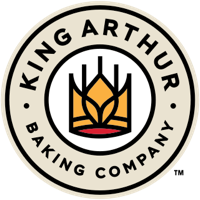Why the hot milk method makes the best birthday cakes
Rich taste, moist texture, and a fail-proof process — what more could you want?
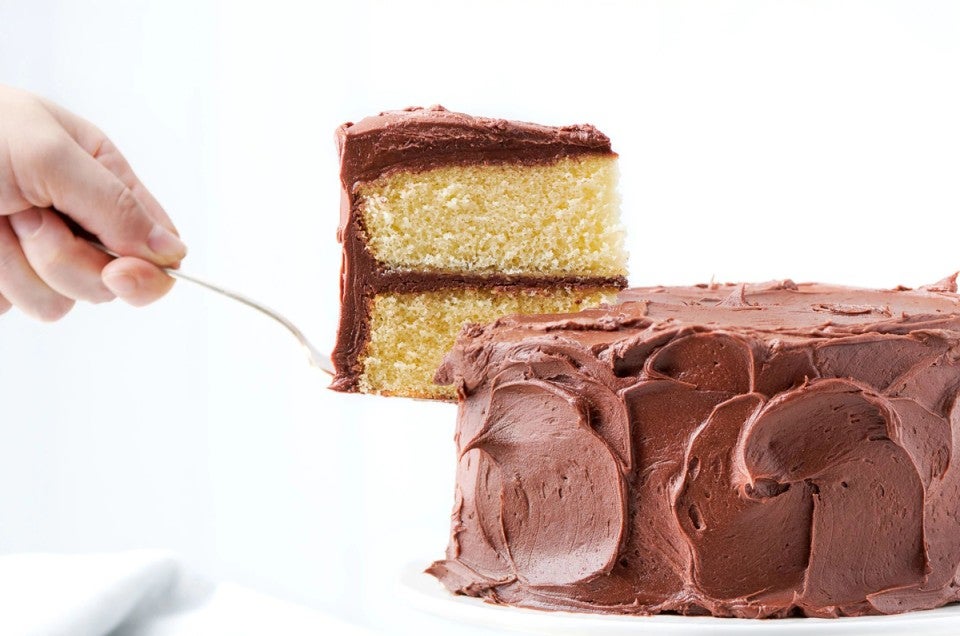

Since debuting as our 2019 Recipe of the Year, Classic Birthday Cake has become an all-time favorite for many bakers — their go-to for a moist and rich yellow cake. But what makes this beloved cake so great?
After all, it might look like a basic, classic cake recipe: The eggs and sugar are beaten together to give it volume (like a genoise, but much less fussy — we’ll get to this below), and like a typical sponge cake recipe, once the eggs and sugar reach the “ribbon stage,” the flour gets gently mixed in. But there’s one step that makes this cake stand out among the rest: It’s a “hot milk cake.”
A hot milk cake utilizes a method where milk and butter (and sometimes oil) are heated until the butter melts. That warm liquid is then added to the whipped eggs, sugar, and dry ingredients and beaten briefly into a homogenous batter. It’s used in recipes like the aforementioned Classic Birthday Cake, as well as another King Arthur favorite: Chef Zeb’s Hot Milk Cake.
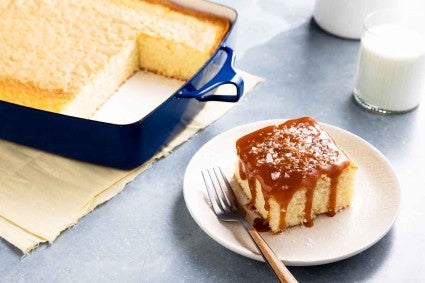
Think of hot milk cake as an egg-leavened cake with a boost. To put it in perspective, let’s compare it to another sponge cake: a genoise. Both cakes are made with beaten eggs that create a light, fluffy texture. But genoise gets its rise entirely from those eggs, instead of relying on leaveners like baking powder or soda. This makes for a fussier cake: If the eggs aren’t heated to just the right temperature (about 110°F), if your batter doesn’t reach the ribbon stage perfectly, and if your flour is folded in a little too roughly, you can end up with a very dense cake.
Hot milk cake, on the other hand, is an easier, more fail-proof type of sponge cake. While it’s made with whipped eggs for great texture, it also includes chemical leaveners for an extra boost — if you accidentally knock too much air out of the batter while mixing, you’ll still get nice rise in the oven thanks to baking soda and/or baking powder. (Chiffon cake is similar — it’s egg-leavened with the addition of baking powder for backup lift, but also requires the extra steps of beating egg yolks and whites separately, resulting in a much taller, airier, more cloudlike texture that’s unlike most classic American birthday cakes.)
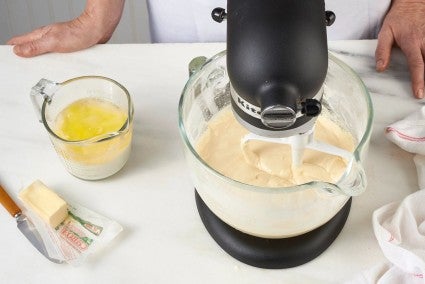
There’s one additional distinction here: that hot milk mixture. Let’s talk about what it does to those eggs! When eggs are cooked, they go through a process called “denaturation,” wherein the coiled structure of egg protein molecules unravel (their “nature” changes), bond with each other, and form clusters (a process called “coagulation”). It’s what makes an egg white go from clear to white when heated, and it’s the same process that gives baked cake its shape and structure.
Think of egg proteins in cake batters like a bunch of tight little knots. Friction (through mixing) shakes those knots around, loosening them, until they come apart into strands. When the eggs are heated, those strands come back together and form new knots full of air, which is essential to leavening. With cake recipes like a genoise, by slightly warming the eggs prior to mixing them in the batter (what we call “tempering”), we’re giving them a head start in this process, which means those proteins have already begun to bind with each other prior to going into the oven; this gives our finished cake a more defined and lofty structure.
With our Classic Birthday Cake recipe, the hot milk mixture kicks off this tempering process, but in a less finicky way. When we add the hot milk and melted butter mixture to the other ingredients, a gentle bit of coagulation begins, giving us that head start. Those egg protein knots, which have been loosened in our mixing process, start to come together as the heat of the hot milk mixture interacts with them. So again, we’re mimicking the process that takes place in a genoise recipe, but in a more controlled and less temperamental way.
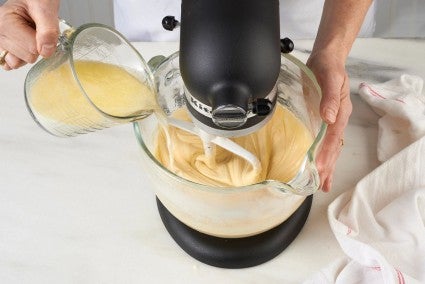
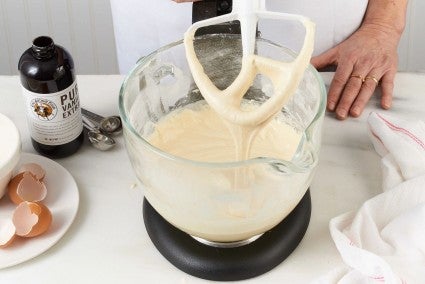
And let’s not forget that it’s a hot milk and butter mixture. Melting the butter before adding it to the batter helps create great texture in your cake. Why? Remember that unlike with bread baking, we want to avoid too much gluten development in our cake batters. Since the butter in hot milk cake is melted prior to being mixed into the batter (and the other primary fat, oil, is already in a liquid state), it more easily coats flour proteins and prevents excessive gluten development. This leads to a cake that is tender and soft, but still rich and moist from the fat in the butter, oil, and milk.
Part of what makes a great cake is the finished product, and hot milk cake delivers: It’s tender, lofty, and moist. But another aspect of a great cake recipe is ease of success. Any cake is high pressure, and birthday cakes even more so. The last thing you want is a subpar cake for the birthday person on their big day!
That’s why our Classic Birthday Cake uses the hot milk method. This technique helps guarantee success — even if you beat too much air out of your eggs or accidentally over-mix the batter, you’ll still end up with a delicious cake. While writing about hot milk cake for Epicurious, Genevieve Yam cited bakers as far back as the 1930s marveling at this reliability: One baker called it “one of those ‘never-fail recipes’” while another proclaimed it “unfailing.”
Don’t just take our word for it, though. Bake up our Classic Birthday Cake this week and see for yourself — no actual birthdays required.
Baking gluten-free? See our recipes for Gluten-Free Classic Birthday Cake and Gluten-Free Hot Milk Cake.
Cover photo (Classic Birthday Cake) by Ryan Bent.

